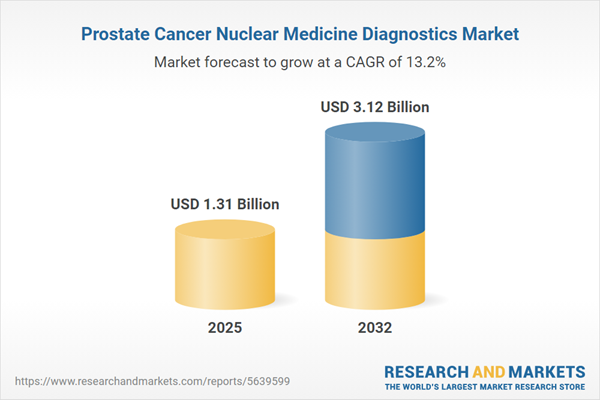Speak directly to the analyst to clarify any post sales queries you may have.
The prostate cancer nuclear medicine diagnostics market is experiencing rapid transformation powered by advanced imaging technologies and innovative radiopharmaceutical agents. Healthcare leaders are leveraging these innovations to enhance early disease detection, personalize therapy, and improve patient outcomes, setting new standards for clinical practice and operational excellence.
Market Snapshot: Prostate Cancer Nuclear Medicine Diagnostics
The global prostate cancer nuclear medicine diagnostics market grew from USD 1.15 billion in 2024 to USD 1.31 billion by 2025. It is projected to continue expanding at a CAGR of 13.19%, ultimately reaching USD 3.12 billion by 2032. This growth is fueled by the deployment of advanced radiotracers, hybrid imaging systems, and evolving clinical applications. Market players are responding to increasing demand for both precise lesion localization and comprehensive treatment monitoring, particularly as emerging technologies move from research to mainstream clinical adoption.
Scope & Segmentation
This comprehensive report examines key segments and market drivers:
- Radiopharmaceuticals: 11C Choline, 18F DcfpyL, 18F Fluciclovine, 68Ga Psma, 18F Psma 1007, 64Cu Psma, along with other emerging agents tailored for improved accuracy and imaging logistics.
- Imaging Modalities: PET, Digital PET, Time of Flight PET, SPECT, SPECT/CT, and advanced hybrid solutions that support detailed anatomical and functional assessments.
- End Users: Academic research institutes, diagnostic centers, and hospitals, each addressing distinct patient pathways and throughput requirements.
- Clinical Indications: Biochemical recurrence detection, initial staging for newly diagnosed patients, and ongoing treatment monitoring for systemic and localized therapies.
- Regional Analysis: Detailed coverage extends across North America (United States, Canada, Mexico), Latin America (Brazil, Argentina, Chile, Colombia, Peru), Europe (United Kingdom, Germany, France, Russia, Italy, Spain, Netherlands, Sweden, Poland, Switzerland), the Middle East (UAE, Saudi Arabia, Qatar, Turkey, Israel), Africa (South Africa, Nigeria, Egypt, Kenya), and Asia-Pacific (China, India, Japan, Australia, South Korea, Indonesia, Thailand, Malaysia, Singapore, Taiwan).
- Company Profiles: In-depth analyses include GE HealthCare Technologies Inc., Siemens Healthineers AG, Koninklijke Philips N.V., Cardinal Health, Bayer AG, Lantheus Holdings, Bracco Imaging, Telix Pharmaceuticals, Eckert & Ziegler Strahlen- und Medizintechnik AG, and Isotope Technologies Munich SE.
Key Takeaways for Senior Decision-Makers
- Next-generation radiotracers, including PSMA-targeted compounds, are redefining diagnostic algorithms and enabling more personalized treatment strategies.
- Hybrid imaging platforms such as PET/CT and PET/MRI have increased the clarity and diagnostic power of nuclear medicine, supporting better lesion detection and monitoring response to therapy.
- Segment growth is driven by a diverse set of end users, from academic research centers leading clinical validation to hospitals managing high-volume integrated care.
- Emerging regions in Asia-Pacific and select Latin American markets are showing dynamic adoption trends, supported by expanding infrastructure and focused public-private initiatives.
- Major industry players are structuring partnerships, investing in localized manufacturing, and scaling innovative tracers to mitigate regulatory and supply chain complexities.
- Increasing adoption of automated image analysis, machine learning, and streamlined reporting platforms is boosting workflow efficiency and decision-making accuracy for clinicians.
Tariff Impact Analysis
The introduction of cumulative tariff measures in the United States in 2025 has generated new strategic imperatives for market stakeholders. These tariffs, affecting radiopharmaceuticals, isotopes, and imaging equipment, have driven companies to reconfigure supply chains, pursue domestic production hubs, and enter collaborative agreements to ensure stable, cost-effective reagent sources. The evolving regulatory environment is influencing procurement, R&D budgets, and the pace of clinical innovation, underscoring the necessity for flexible sourcing and adaptable operational models.
Methodology & Data Sources
This report builds on primary interviews with clinicians, radiopharmacists, imaging specialists, procurement executives, and supply chain managers. These insights were reinforced by systematic secondary research, including analysis of peer-reviewed literature, clinical trial registries, regulatory documents, and tariff-focused datasets. Analytical validation included cross-referencing with internal databases, scenario modeling, and expert panel reviews to ensure robust, actionable findings.
Why This Report Matters
- Delivers validated insights into emerging technologies, supply dynamics, and geographic adoption patterns to support strategic business planning.
- Clarifies the impact of recent policy changes and evolving clinical workflows, guiding effective decision-making for investments and partnerships.
- Empowers leaders to navigate complex regulatory, procurement, and reimbursement landscapes with current, granular data aligned to market realities.
Conclusion
The prostate cancer nuclear medicine diagnostics market is characterized by ongoing technological innovation, evolving regional dynamics, and adaptive strategies by leading suppliers. Stakeholders equipped with accurate, timely insights are well positioned to drive informed, sustainable growth in this evolving sector.
Additional Product Information:
- Purchase of this report includes 1 year online access with quarterly updates.
- This report can be updated on request. Please contact our Customer Experience team using the Ask a Question widget on our website.
Table of Contents
3. Executive Summary
4. Market Overview
7. Cumulative Impact of Artificial Intelligence 2025
Companies Mentioned
The companies profiled in this Prostate Cancer Nuclear Medicine Diagnostics market report include:- GE HealthCare Technologies Inc.
- Siemens Healthineers AG
- Koninklijke Philips N.V.
- Cardinal Health, Inc.
- Bayer AG
- Lantheus Holdings, Inc.
- Bracco Imaging S.p.A.
- Telix Pharmaceuticals Limited
- Eckert & Ziegler Strahlen- und Medizintechnik AG
- Isotope Technologies Munich SE
Table Information
| Report Attribute | Details |
|---|---|
| No. of Pages | 183 |
| Published | October 2025 |
| Forecast Period | 2025 - 2032 |
| Estimated Market Value ( USD | $ 1.31 Billion |
| Forecasted Market Value ( USD | $ 3.12 Billion |
| Compound Annual Growth Rate | 13.1% |
| Regions Covered | Global |
| No. of Companies Mentioned | 11 |









